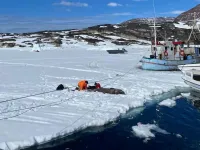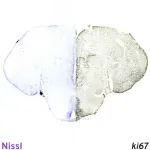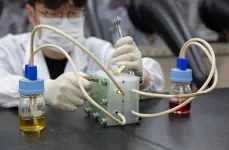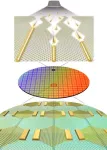(Press-News.org) New research finds surprising differences in the diets and gut microbiomes of songbirds living in the radiation contaminated areas of the Chornobyl Exclusion Zone, Ukraine. This study is also the first to examine the breeding behaviour and early life of birds growing up in radiologically contaminated habitats.
The Chornobyl Exclusion Zone (Ukrainian), also known as the Chernobyl Exclusion Zone (Russian), is an area of approximately 2,600 km2 of radiologically contaminated land that surrounds the Chornobyl Nuclear Power Plant. The levels of contamination are uneven throughout the zone.
“The consequences of radiological contamination to wildlife are still widely unknown, especially the risks posed to wildlife in early life,” says Mr Sameli Piirto, a PhD researcher at the University of Jyväskylä, Finland. “Our hypothesis was that biodiversity in contaminated areas would be compromised leading to changes in birds breeding, diet and gut microbiome.”
To examine the effects of radiological contamination on bird development, Mr Piirto and his team investigated the breeding behaviours and physiologies of two common European songbird species, Great tit (Parus major) and Pied Flycatcher (Ficedula hypoleuca). These were selected due to their well-studied ecologies.
Nest boxes were placed in multiple areas that belonged to two categories within the Chornobyl Exclusion Zone: areas of high radiological contamination and areas of low contamination. The nestling and adult birds that used the nest boxes were then monitored, with DNA from fecal samples being used to study the birds’ diets and characterise their gut microbial communities.
Mr Piirto found that while nest occupancy rate was lower in contaminated areas, there were no other major differences in breeding ecology or nestling health between the two levels of radiation contamination for either species. Surprisingly, both species nestlings were found to actually have a higher diversity of insects in their diet in the contaminated areas.
While environmental radiation levels were not associated with bacterial diversity of the gut microbiome, radiation level was associated with the relative composition of the microbiome. “These results create an interesting background for understanding avian ecology in radiologically contaminated areas,” says Mr Piirto. “They give us valuable novel information on the effects that radiation has on juvenile birds - an area of research that has been unclear until now.”
This research can help to provide insights into the long-term effects of nuclear accidents on wildlife health. “Radiological contamination creates an additional stressor that organisms must cope with, leading to a myriad of consequences that are not yet fully understood,” says Mr Piirto. “Studying the effects of it is crucial if humanity is to pursue an even more nuclear future.”
This research is being presented at the Society for Experimental Biology Annual Conference in Prague on the 2-5th July 2024.
END
Exploring bird breeding behaviour and microbiomes in the radioactive Chornobyl Exclusion Zone
2024-07-03
ELSE PRESS RELEASES FROM THIS DATE:
Discovering new anti-aging secrets from the world’s longest-living vertebrate
2024-07-03
New experimental research shows that muscle metabolic activity may be an important factor in the incredible longevity of the world’s oldest living vertebrate species – the Greenland shark. These findings may have applications for conservation of this vulnerable species against climate change or even for human cardiovascular health.
Greenland sharks (Somniosus microcephalus) are the longest living vertebrate with an expected lifespan of at least 270 years and possible lifespan beyond 500 years. “We want to understand what adaptations ...
Pregnant fish can also get “baby brain”, but not the way that mammals do
2024-07-03
New research reveals that pregnancy-related brain impairment is present in live-bearing fish, but instead of affecting learning and memory as expected from similar research on mammals, it appears to have a stronger impact on decision-making and sensory reception.
There have been many studies into the detrimental impact of pregnancy on mammalian brains, sometimes called “baby brain” or “momnesia” in humans, revealing how the disruption of neurological processes like neurogenesis, or the creation ...
Pasteurization inactivates highly infectious avian flu in milk
2024-07-03
Highlights:
• In late March 2024, H5N1 bird flu was detected in dairy cattle and then in raw milk.
• Researchers tested hundreds of milk products from dozens of states for the virus.
• No infectious virus was found in pasteurized milk products.
• Non-infectious traces of viral genetic material were found in 20% of samples.
Washington, D.C.—In March 2024, dairy cows in Texas were found to be infected with highly pathogenic avian flu, ...
KIER develops 'viologen redox flow battery' to replace vanadium’
2024-07-03
A technology has been developed to replace the active material in large-capacity ESS 'redox flow batteries' with a more affordable substance.
*Redox Flow Battery: A term synthesized from Reduction, Oxidation, and Flow. It is a battery that stores electrical energy as chemical energy through oxidation and reduction reactions of active materials in the electrolyte at the electrode surface and converts it back to electrical energy when needed. It is capable of large-scale storage, can be used long-term through periodic replacement of the electrolyte, and its major advantage is the absence of fire risk.
Dr. Seunghae Hwang’s ...
Chemists synthesize an improved building block for medicines
2024-07-03
Chemists have overcome a major hurdle in synthesizing a more stable form of heterocycle—a family of organic compounds that are a common component of most modern pharmaceuticals.
The research, which could expand the toolkit available to drug developers in improving the safety profiles of medications and reducing side effects, was published in Science by organic chemists at the University of British Columbia (UBC), the Massachusetts Institute of Technology (MIT), and the University of Michigan.
“Azetidines ...
A genetic algorithm for phononic crystals
2024-07-03
Tokyo, Japan – The advent of quantum computers promises to revolutionize computing by solving complex problems exponentially more rapidly than classical computers. However, today's quantum computers face challenges such as maintaining stability and transporting quantum information. Phonons, which are quantized vibrations in periodic lattices, offer new ways to improve these systems by enhancing qubit interactions and providing more reliable information conversion. Phonons also facilitate better communication ...
Machine learning could aid efforts to answer long-standing astrophysical questions
2024-07-03
In an ongoing game of cosmic hide and seek, scientists have a new tool that may give them an edge. Physicists at the U.S. Department of Energy’s (DOE) Princeton Plasma Physics Laboratory (PPPL) have developed a computer program incorporating machine learning that could help identify blobs of plasma in outer space known as plasmoids. In a novel twist, the program has been trained using simulated data.
The program will sift through reams of data gathered by spacecraft in the magnetosphere, the region of outer space strongly affected by Earth’s ...
Research spotlight: Uncovering how a cellular miscommunication leads to cognitive impairment in female patients with Alzheimer’s disease
2024-07-03
Lead author Neta Rosenzweig, PhD, of the Ann Romney Center for Neurological Diseases, and senior author Oleg Butovsky, PhD, of the Ann Romney Center and Gene Lay Institute of Immunology and Inflammation, share key messages from their paper “Sex-Dependent APOE4 Neutrophil-Microglia Interactions Drive Cognitive Impairment in Alzheimer’s Disease” published in Nature Medicine.
How would you summarize your study for a lay audience?
In this manuscript, we identify that a major genetic risk ...
AI model to improve patient response to cancer therapy
2024-07-03
A new artificial intelligence (AI) tool that can help to select the most suitable treatment for cancer patients has been developed by researchers at The Australian National University (ANU).
DeepPT, developed in collaboration with scientists at the National Cancer Institute in America and pharmaceutical company Pangea Biomed, works by predicting a patient’s messenger RNA (mRNA) profile. This mRNA - essential for protein production - is also the key molecular information for personalised cancer medicine.
According to lead author Dr Danh-Tai Hoang from ANU, when combined with a second tool called ENLIGHT, DeepPT ...
Scientists discover way to “grow” sub-nanometer sized transistors
2024-07-03
A research team led by Director JO Moon-Ho of the Center for Van der Waals Quantum Solids within the Institute for Basic Science (IBS) has implemented a novel method to achieve epitaxial growth of 1D metallic materials with a width of less than 1 nm. The group applied this process to develop a new structure for 2D semiconductor logic circuits. Notably, they used the 1D metals as a gate electrode of the ultra-miniaturized transistor.
Integrated devices based on two-dimensional (2D) semiconductors, which exhibit excellent properties even at the ultimate limit of material thickness down to the atomic ...






